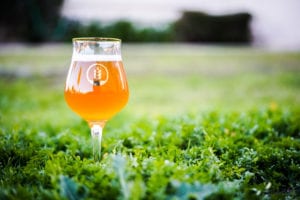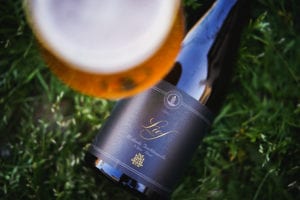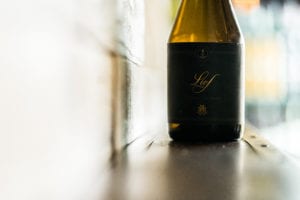The Story Behind Lief: How a Belgian Tradition Takes New Roots in San Diego
The Story Behind Lief: How a Belgian Tradition Takes New Roots in San Diego
Posted by Winslow Sawyer
4 years ago | March 15, 2021
Estimated Reading Time: 6 minutes, 53 seconds
ORIGINAL SAN DIEGO FLAVORS STEEPED IN OLD TRADITION
The very first brew we ever brewed–Lief–has origins way back, long before Pure ever came to be. Think medieval Europe, during the times of kingdoms, not countries.
Lief’s name means “loved one”; we love the way it maintains the integrity of the Belgian method of making traditional lambic. It is our Méthode Traditionnelle (MT3) blend of one-, two-, and three-year-old spontaneously fermented ales.
Yet unlike its predecessors, Lief is Purely unique to the microflora, climate, and ecology of San Diego county.
WHAT IS LIEF?
Lief is a lambic-inspired wild ale. But we can’t tell the tale of Lief without first telling the story of lambic, gueuze, and Méthode Traditionnelle. It’s a wild one (pun intended), so grab yourself a bottle of our third annual batch of this special brew (if you haven’t already), and enjoy learning about one of the oldest styles of beer and how Lief came to be.
LAMBIC: A TRUE LEGACY
With roots that date back to the 13th century, lambic is a style of beer brewed in the Pajottenland region of Belgium, an extremely fertile agricultural area in the Zenne and Dendre river valley and western Brussels. Traditional lambic is fermented through exposure to wild yeasts and bacteria native to this area.
Aside from its specific region of origin, the process of making lambic is incredibly unique. Take everything you know about making a traditional ale or lager and throw it out the window.
WHAT MAKES BREWING A LAMBIC UNIQUE
⇒ Turbid mash
Lambic wort (steeped grain liquid) is built on a grain bill with a large fraction of raw, unmalted wheat and is produced through a labor-intensive process called turbid mashing. A turbid mash involves the preservation of highly complex and indigestible sugars so that the naturally occurring yeast in the beer has something to eat throughout an abnormally long fermentation.
⇒ Long boil with aged hops
The wort boils for a very long time (three hours and up, while many other beers only undergo an hour boil) with the addition of aged hops, aged from one to over three years. The process of exposing hops to oxygen at room temperature over time degrades the alpha acids, the part of the hops that give them bitterness and antimicrobial properties. Aged hops contribute unique, funky flavors and aromas to the beer, without a strong bitterness or inhibition of the mixed cultures. The aged hops also help to preserve the beer during its long fermentation.
⇒ Spontaneous fermentation
Lambic is spontaneously fermented, meaning the beer is transferred from the boiling tank to open coolships (large shallow troughs), where it is left to cool in open air for upwards of 15 hours. This process invites naturally occurring microorganisms and wild yeast from the environment into the beer to convert the sugar into alcohol. Spontaneous fermentation usually happens in a specific region and season, and in cooler climates. The making of lambic long precedes the creation and addition of single strains of brewers yeast in a controlled environment that we often see today. Once cooled, the beer is transferred to a holding tank before being aged in oak barrels for one to three years.
Starting with a labor-intensive turbid mashing process to preserve unfermentable sugars, the developing lambic goes in for a long boil with aged hops that impart unique, funky flavors to the beer. And then the pièce de résistance: the beer is cooled in an open air container to invite naturally occurring microorganisms and wild yeast from the environment into the beer to convert the sugar into alcohol.
The result of this process is a funky, sour beer that varies wildly from batch to batch. There is perhaps no style of beer more closely linked to place than lambic. Not only are there centuries of history rooting the beer to a specific region, but the nature of the fermentation leads to beer that is uniquely associated with place and environment.

GUEUZE: THE PERFECT BLEND
Gueuze is what you get when you blend a young lambic (~one year old) with an old lambic (~two to three years old), and bottle it for a second fermentation. Because the young lambic is not fully fermented, the blended beer contains fermentable sugars which allow a second fermentation to occur. The result is a finely carbonated and amazingly complex beer, often called the “Champagne of Brussels.”
MÉTHODE TRADITIONNELLE: FOR THE AMERICAN PURISTS
There was a struggle in the American sour beer community for years about what to call beers brewed in the tradition of lambic—beers that follow the process with a turbid mash, long boil, aged hops, coolship, and spontaneous fermentation—but are not produced in the Pajottenland region of Belgium.
Most brewers have the utmost respect for the tradition of lambic; the struggle comes from attempting to say where the inspiration came from, and how the beer was made, without using the terms “lambic” or “gueuze” in the name or style description of the beer.
Though lambic is not legally protected like Champagne—which can only be used if the product is made within France’s Champagne region—it is a culturally protected and revered mark.
In 2016 a group of American brewers, led by Jester King (a brewery committed to mixed culture and spontaneous fermentation in Austin, Texas), met with the High Council for Artisanal Lambic Beers (HORAL), an organization composed of the vast majority of lambic breweries from the Pajottenland region of Belgium. Their goal: to come up with a term and definition American brewers could use when producing lambic-inspired beers that respects lambic history and tradition, and establishes a production standard inspired by the Belgian brewers of the Pajottenland region.
After much discussion and debate, the lambic-loving American brewers and HORAL settled on a term: Méthode Traditionnelle.
Méthode Traditionnelle, or MT, refers to beers produced outside of Belgium using the method of making traditional lambic.
 MÉTHODE TRADITIONNELLE — 3 YEAR BLEND: FOR THE PATIENT PURISTS
MÉTHODE TRADITIONNELLE — 3 YEAR BLEND: FOR THE PATIENT PURISTS
Méthode Traditionnelle – 3 Year Blend is a blend of one-, two-, and three-year-old Méthode Traditionnelle, in the tradition of gueuze.
According to the Méthode Traditionnelle website, “For brewers making a G(u)euze-inspired blend of three or more seasons of 100% spontaneously fermented beer produced using the traditional method, they may use the “Méthode Traditionnelle — 3 Year Blend” a.k.a. “MT3” logo.” You can see the official MT3 certification mark on our latest Lief label.
LIEF: A WILD TASTE OF SAN DIEGO

 Lief is our Méthode Traditionnelle (MT3). The one- and two-year barrels were fermented solely near the brewery in Miramar, while the three-year barrels were fermented solely by wild yeasts indigenous to Cuyamaca Park on a Pure lambic camping trip. Microorganisms from the San Diego air infuse every sip.
Lief is our Méthode Traditionnelle (MT3). The one- and two-year barrels were fermented solely near the brewery in Miramar, while the three-year barrels were fermented solely by wild yeasts indigenous to Cuyamaca Park on a Pure lambic camping trip. Microorganisms from the San Diego air infuse every sip.
California-grown Pilsner malt and raw, unmalted wheat provide the foundation of this blend. Warm-aged hops added to the boil provide aromas of funk, Asian pear, and earthiness. High levels of carbonation make for a brew that practically dances on your tongue with tastes of fine cork, bready malt and gooseberry. The bright acidity upfront gives way to a smooth and refined finish that is both dry and refreshing.
Lief is an ode to the Belgian roots of beer making, and we love the way it is uniquely Pure and San Diego. Curiously thirsty yet? Click the link below to get your hands on our newest batch of Lief, batch #6!
LIEF – IN THE NEWS:
Check out this article about Lief published by Edible San Diego, San Diego in a Glass.
What is a Lambic Beer?
Lambic beer is a traditional style of beer that originates from the Pajottenland region of Belgium. It is known for its distinct sour and funky flavors, which are a result of spontaneous fermentation. Unlike most beers which use carefully controlled strains of yeast, Lambic beers are exposed to the open air to be inoculated by wild yeasts and bacteria. This process results in a complex beer with flavors that can include sourness, barnyard, hay, and various fruit characteristics.
Does Lambic Beer Have Alcohol?
Yes, Lambic beer does contain alcohol. The alcohol content of Lambic beers typically ranges from 4% to 8% ABV (alcohol by volume), which is similar to many other styles of beer. The alcohol is produced during the fermentation process as the wild yeasts and bacteria consume the sugars present in the wort.
Is Lambic Beer Gluten Free?
Lambic beer is not gluten-free. It is brewed with malted barley and often a significant amount of wheat, both of which contain gluten. People with celiac disease or a sensitivity to gluten should avoid drinking Lambic beers and opt for beers that are specifically labeled as gluten-free.






